Download a PDF copy of this article by clicking here.
![]()
The creative destruction of location-based entertainment
by Randy White, CEO White Hutchinson Leisure & Learning Group
 The first Digital Out-of-Home Interactive Entertainment Conference was held in London, UK on July 14, 2011. Randy White, our CEO, gave the keynote speech at the conference. This article covers material included in Randy's conference presentation, The Creative Destruction of Location. A version of this article was first published on Blooloop.com and a later version in the White Hutchinson Leisure & Learning Group Leisure eNewsletter.
The first Digital Out-of-Home Interactive Entertainment Conference was held in London, UK on July 14, 2011. Randy White, our CEO, gave the keynote speech at the conference. This article covers material included in Randy's conference presentation, The Creative Destruction of Location. A version of this article was first published on Blooloop.com and a later version in the White Hutchinson Leisure & Learning Group Leisure eNewsletter.
Creative destruction occurs when something new displaces something older, typically brought about by a disruptive new technology. Location-based, or what we will also call venue-based entertainment, has been through a number of creative destructions, with perhaps the most dramatic and threatening one currently underway. This article looks at the evolution of both the entertainment market and consumer and discusses what entertainment venues can do to compete and survive.
The earliest entertainment
In the earliest days of humans there was no such thing as location-based entertainment. Early humans would gather around the campfire to socialize and share food 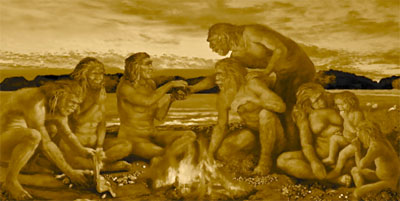 with storytelling or dancing being their entertainment. Eventually tribes came together at some location for tribal gatherings, again enjoying food together, telling stories, dancing and probably also enjoying some sport-type games. Location-based entertainment was born, even if it only took place on a temporary basis.
with storytelling or dancing being their entertainment. Eventually tribes came together at some location for tribal gatherings, again enjoying food together, telling stories, dancing and probably also enjoying some sport-type games. Location-based entertainment was born, even if it only took place on a temporary basis.
It wasn't until much later in human history that permanent location-based venues developed. The Greeks had theater and the Romans their coliseums. Permanent out-of-home entertainment venues continued to evolve with the pleasure gardens in Medieval Europe, trolley parks (early versions of amusement parks) in the late 1800s, the first modern amusement park in 1894, Disneyworld - the first theme park - in 1955 and the many other theme parks and venue-based entertainment concepts that followed.
Meanwhile, at-home entertainment for the masses remained limited to things like board games, the earliest known being Egyptian senet, c. 3500 BC, and perhaps some family member playing a musical instrument or singing.
Milestones in the evolution of entertainment
It wasn't until the introduction of the phonograph in 1877 that more varied forms of entertainment came to the home. The phonograph for the first time mass-produced a form of entertainment previously only available out of the home. This might be the first instance of at-home entertainment competing with location-based entertainment. You no longer had to leave the home to enjoy music.
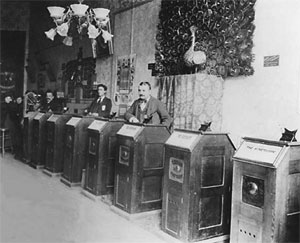 Evolution from this point onwards progressed quickly:
Evolution from this point onwards progressed quickly:
- The bar was raised for out-of-home entertainment with the first kinescope parlor in 1894 and the first movie theater in 1896. Suddenly there was a new form of entertainment that was not available at home.
- Disruption to location-based entertainment came again with the radio in 1920 and the television in 1941. Both brought live entertainment into the home.
- It wasn't long thereafter that we saw the first creative disruption to both at-home and location-based entertainment with the introduction of the vacuum tube portable radio in 1945 followed by the even smaller transistor radio in 1954. For the first time entertainment was no longer location dependent.
- The digital age arrived in 1971 with the first microprocessor and the first arcade video game, Galaxy, followed one year later by Pong. In 1972, the first at-home video game arrived, the Magnavox Odyssey. The age of the video game was here.
- 1974 saw the first computer, the IBM 1500PC, and in 1995, the World Wide Web came to consumers. Both have had a more dramatic impact on location-based entertainment than any disruptive technologies that came before.
- Disruption to location dependent entertainment came again in the early 1980s with the portable laptop computer, in 2001 with the iPod, then the iPhone smartphone in 2007 and finally the iPad in 2010. Consumers no longer had to ever be offline from the vast entertainment and social media resources the Internet offered. During the same era we saw the birth of social media with MySpace in 2003 and Facebook in 2004. Simultaneously, the quality of at-home video consoles and their games advanced to now include gesture and motion-based control.
Entertainment – a zero sum game
Now we have three competing types of entertainment—at-home, venue-based and mobile—competing for the zero sum game of our average of five hours of leisure time a day, the amount of which has not varied by more than few minutes over the past three decades.
Our company's research shows that the digital world is causing the creative destruction of venue-based entertainment and leisure. Between 2003 and 2010, the amount of time Americans spent playing video games and using the computer for leisure increased 28% and time in front of the television increased 9%. The time spent playing computer and video games increased 39%. December 2010 data in the UK shows that 45% of a Brit's awake time is now spent with media and e-communications. Since it’s a zero sum game, time for other leisure activities, including visiting entertainment and leisure venues, has decreased 39%. This is supported by 2010 data on North American cinema attendance, down 22% since 2002 on a per capita basis and data on the percentage of American's visiting art venues and museums, movie theaters, sporting events and historic sites and parks, all down with the decline starting back in the late 1990's.
Consumer spending
Consumer expenditure data also supports the creative destruction of location-based entertainment. Average household expenditures (inflation adjusted) on electronic equipment and services (includes video games) were up 26% in 2009 compared to 2000, whereas venue-based entertainment expenditures were down 2%. When we look at venue-based entertainment expenditures in greater detail, it was down dramatically for all but those households with the top 20% of incomes, with the decrease in spending being inverse to incomes. Yet, all income groups saw more than a doubling of spending (+111%) on video game hardware and software over the same nine years, ranging from 91% for the quintile of highest income households to 214% for the 20% of households with the lowest incomes.
Throughout the past decade, a larger proportion of all out-of-home entertainment spending has been shifting to higher income households. The trend started many years before the Great Recession. In 2009 the top 40% of households by income accounted for 71% of such spending, up from 64% in 2000. This is a phenomenon known as the social stratification of out-of-home entertainment.
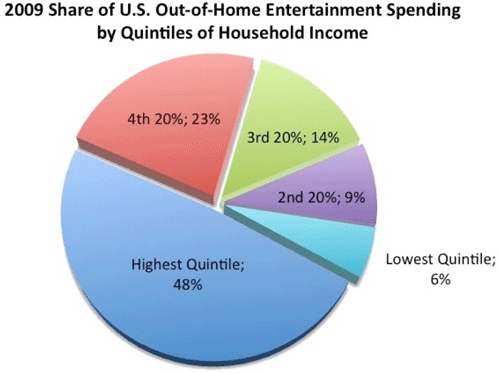
Socialization is the culprit
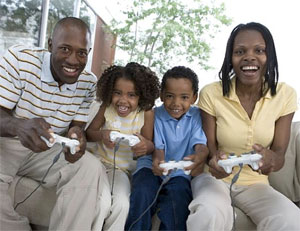 Both at-home and mobile video games and social media are the primary cause of the creeping creative destruction of venue-based entertainment. It's socialization that is really the culprit. 80% of video game players are socializers; they play for the social aspects of video games rather than for the game itself. 10% are achievers and 9% explorers. You have to be part of a social community to brag about your achievements and share you discoveries. And of course, social media is all about socialization. Research shows that the brain reacts as positively to forms of digital communication and socialization as it does to in person communication. Video games activate all the neurological and psychological systems that bring us pleasure and happiness. Video games are mood enhancing. They cause the release of dopamine, increasing their appeal and addictiveness. We humans are hedonistic creatures that pursue what brings us the most happiness and pleasure. Virtuality can actually be better and more appealing than reality itself.
Both at-home and mobile video games and social media are the primary cause of the creeping creative destruction of venue-based entertainment. It's socialization that is really the culprit. 80% of video game players are socializers; they play for the social aspects of video games rather than for the game itself. 10% are achievers and 9% explorers. You have to be part of a social community to brag about your achievements and share you discoveries. And of course, social media is all about socialization. Research shows that the brain reacts as positively to forms of digital communication and socialization as it does to in person communication. Video games activate all the neurological and psychological systems that bring us pleasure and happiness. Video games are mood enhancing. They cause the release of dopamine, increasing their appeal and addictiveness. We humans are hedonistic creatures that pursue what brings us the most happiness and pleasure. Virtuality can actually be better and more appealing than reality itself.
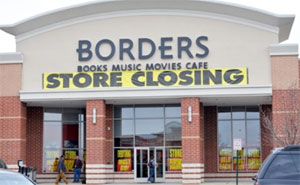 It is interesting as a side note that not only is the digital world causing the creative destructive of venue-based entertainment, it is doing the same to bricks-and-mortar commercial office space and retail stores. In the 1970s, we used around 600 square feet of office space per person. Today it is down to 200 square feet. Jones Lang LaSalle predicts it will be down to 50 square feet in 2015. You no longer need a physical office to conduct business, just a device that can connect to the Internet, whether at-home, on the move or in a coffee shop. Internet retail now accounts for 8% of retail sales. It is projected to grow to 15% in 2015. We have already seen the demise of most stores that sell music CDs, Videotapes, DVDs and books, as their Internet delivered digital equivalents have replaced them.
It is interesting as a side note that not only is the digital world causing the creative destructive of venue-based entertainment, it is doing the same to bricks-and-mortar commercial office space and retail stores. In the 1970s, we used around 600 square feet of office space per person. Today it is down to 200 square feet. Jones Lang LaSalle predicts it will be down to 50 square feet in 2015. You no longer need a physical office to conduct business, just a device that can connect to the Internet, whether at-home, on the move or in a coffee shop. Internet retail now accounts for 8% of retail sales. It is projected to grow to 15% in 2015. We have already seen the demise of most stores that sell music CDs, Videotapes, DVDs and books, as their Internet delivered digital equivalents have replaced them.
The Fidelity Belly
As Kevin Maney explains in his book Trade Off, almost every decision consumers make involves a trade-off between fidelity and convenience. Offerings that are at one extreme or the other – either high in fidelity or high in convenience – tend to be successful. To really win, an offering needs to be multiple times better than what you’re aiming to replace, which means many times higher fidelity or many times more convenient. The things that fall into the middle with moderate fidelity or convenience fail to win an enthusiastic audience; this is what Maney calls the fidelity belly. Music fans don't buy CDs as CDs fell into the fidelity belly between high fidelity rock concerts with high-ticket prices and low fidelity, inexpensive convenient MP3 music.
Digital technology is pushing the boundaries of fidelity and convenience, continually raising the bar at each end—high fidelity venue-based entertainment such as Cirque du Soleil and Orlando theme park experiences like the Wizarding World of Harry Potter at Universal Studios and the convenience of the digital world both at-home and on mobile devices. As a result many entertainment venues are losing their appeal and becoming casualties of the fidelity belly.
How to compete with video games and social media?
So how can entertainment venues raise themselves out of the fidelity belly to compete with video games and social media? In many respects, it's about getting back to the basics of early man who gathered around the campfire to socialize, share food and be entertained.
 Food: One thing the digital world can't offer is food and beverage. With an increasing time-pressured society, dining out is perceived as a time saving activity. People in most Western cultures eat out a lot, in fact an average of over 200 times a year for Americans. Those entertainment venues that feature destination food and beverage drive attendance and achieve much higher revenues per square foot than entertainment-only venues. In fact, those venues that achieve a mix of around 50% food and beverage and 50% entertainment, what we call eatertainment, have demonstrated their staying power and long-term profitability, some for over 25 years. There is a synergy when quality food and drink is combined with entertainment, raising the fidelity of the overall experience. Food and drink is essential for success at community-based entertainment venues that only succeed with repeat business. Even tourist-based attractions such as the theme parks understand the importance of food to their success.
Food: One thing the digital world can't offer is food and beverage. With an increasing time-pressured society, dining out is perceived as a time saving activity. People in most Western cultures eat out a lot, in fact an average of over 200 times a year for Americans. Those entertainment venues that feature destination food and beverage drive attendance and achieve much higher revenues per square foot than entertainment-only venues. In fact, those venues that achieve a mix of around 50% food and beverage and 50% entertainment, what we call eatertainment, have demonstrated their staying power and long-term profitability, some for over 25 years. There is a synergy when quality food and drink is combined with entertainment, raising the fidelity of the overall experience. Food and drink is essential for success at community-based entertainment venues that only succeed with repeat business. Even tourist-based attractions such as the theme parks understand the importance of food to their success.- Community: The campfire is a communal experience. We are social animals; that is one of the primary reasons mankind has managed to survive and prosper. When we look at research on the reason people visit entertainment and leisure venues, in almost all instances the primary reason is to socialize, yes socialize, not for the entertainment, viewing the sports or watching the live play. It's no different than the primary reason most people play video games. To compete with the convenience of social media, video games and the rest of the digital world, entertainment venues need to raise the fidelity of the social experience they offer. Research clearly shows that when people socialize in the same space face-to-face, it supercharges the positive emotional impact and strength of social bonding that takes place. We also know that sharing food and drink together strengthens social bonding. Today we often place a candle in the middle of the dining table, reminiscent of our primal instincts to gather, socialize and eat around the campfire. Also incorporating multiple 'social spaces', social seating areas, throughout the venue promotes socialization. We are seeing this trend in many other types of leisure venues including hotel lobbies and health and fitness centers.
- Activity: We also know from research on happiness that we don't feel better after a passive activity like watching a movie, but we are happier after being physically involved in a game or activity with friends. It causes the release of oxytocon into our bloodstreams, a neurochemical that makes us feel good and strengthens bonding. That probably explains the timeless appeal of bowling, billiards, miniature golf and the nascent popularity of bocce. All have a common rhythm of one person playing while the others watch and socialize.
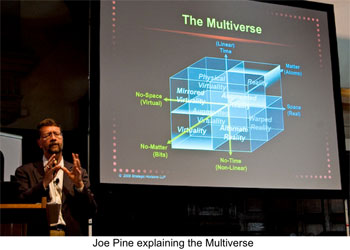 Technology: Digital technology can enhance the venue-based entertainment experience as well. We are seeing the introduction of augmented reality at some venues. There are many untapped opportunities to add fidelity and value to venue-based entertainment experiences using the combinations of reality and virtuality found in the eight quadrants of the Multiverse described in Joe Pine's new book, Infinite Possibility, Creating Customer Value on the Digital Frontier. Venue debit or membership card systems can be used to introduce gamification to the overall venue experience. Tied in with CRM (customer relationship management) back-of-the-house software, guests' visits to entertainment venues can be personalized. Digital technologies as simple as video masking units in bowling centers help raise the fidelity.
Technology: Digital technology can enhance the venue-based entertainment experience as well. We are seeing the introduction of augmented reality at some venues. There are many untapped opportunities to add fidelity and value to venue-based entertainment experiences using the combinations of reality and virtuality found in the eight quadrants of the Multiverse described in Joe Pine's new book, Infinite Possibility, Creating Customer Value on the Digital Frontier. Venue debit or membership card systems can be used to introduce gamification to the overall venue experience. Tied in with CRM (customer relationship management) back-of-the-house software, guests' visits to entertainment venues can be personalized. Digital technologies as simple as video masking units in bowling centers help raise the fidelity.- Efficiency: Time is considered very valuable today. In fact many people are more concerned about wasting their time then wasting their money. Innovations such as advance reservations for all the entertainment offerings enhancesthe appeal as it assures guests that they will efficiently use their disposable leisure time. Back-of-the-house digital technology makes all this possible.
- Customization: We have also been trained, in fact we now expect, to be able to customize everything. It started with Burger King’s, "Have it your way", and now Starbucks gives us 30,000 different drink combinations. Our individual identity and status matters more to us than just about anything else. Anything that enhances it will increase the fidelity of the experience. In a sense, in Western societies, leisure and entertainment are really a form of self-expression and enable Maslowian self-actualization. Enabling the customers to customize their entertainment experience enhances their self-esteem and thus the perceived value of the entertainment offering.
- Convergence: And finally, the experience should no longer be limited to time spent at a bricks-and-mortar location. The venue's brand experience should be extended into the virtual world. This means more than just being on Facebook. It involves what is called convergence in the retail industry, truly extending aspects of the entertainment experience into the virtual world so it can be enjoyed 24/7.
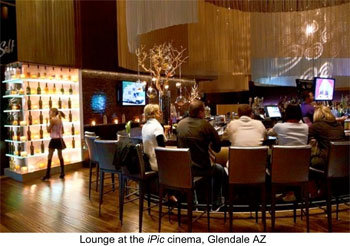 One good example of enhancing fidelity at an entertainment venue is the direction we see many movie theaters taking. Not only are they using digital technology to enhance movie viewing with digital projection, 3D and even 4D offerings, but they are also increasing the social aspect of visiting the movies and in turn, how happy customers feel when they leave. They are installing restaurants, bars and lounges. Some are even adding bowling to add a physical element to the visit experience. Many now offer on-line reservations where you can even reserve your seats.
One good example of enhancing fidelity at an entertainment venue is the direction we see many movie theaters taking. Not only are they using digital technology to enhance movie viewing with digital projection, 3D and even 4D offerings, but they are also increasing the social aspect of visiting the movies and in turn, how happy customers feel when they leave. They are installing restaurants, bars and lounges. Some are even adding bowling to add a physical element to the visit experience. Many now offer on-line reservations where you can even reserve your seats.
The Internet, social media and the digital world are evolving at an ever-increasing speed, becoming even more attractive, convenient and addictive. There can be no doubt that creative destruction by the digital and virtual worlds is eroding market share for a large variety of entertainment and leisure venues, especially those that are not high fidelity. Extinction will probably come to some. The entertainment venues that survive will be those that understand how both the customer AND the playing field are evolving, and can adapt accordingly to stay competitive and prosper in the digital age.


